3D shapes. Lesson summary Topic: "Geometric shapes. Development of a cube"
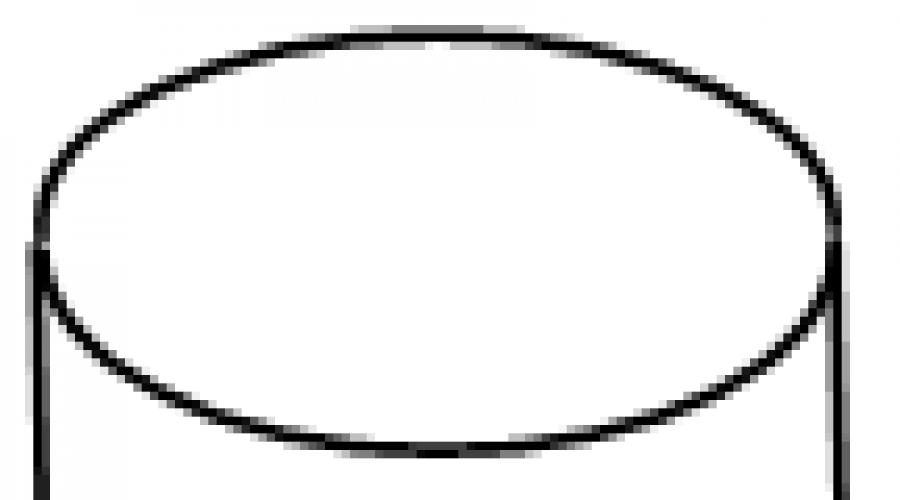
Integrated lesson in mathematics and fine arts in grade 3
Topic: " Geometric figures... Unfolding a cube "
Goals:
generalize ideas about flat geometric shapes and volumetric geometric bodies;
create conditions under which students "discover" the way to obtain a volumetric figure.
Tasks:
to consolidate knowledge of the classification of flat figures and volumetric bodies, their fundamental differences; to acquaint with the concepts of "bodies of revolution" and "polyhedra";
create conditions for creative search in finding a match between spatial view a cube and its flat image (scan);
develop logical and spatial thinking, attention, memory, imagination, creativity;
educate accuracy, compliance with safety rules when working with tools.
Equipment: interactive whiteboard, presentation, models of three-dimensional geometric shapes, handouts (individual cards).
During the classes.
I. Organizing time.
II. Updating basic knowledge.
Guys, today our lesson is about geometry.
Let's remember what geometry is? (Translated from Greek, the word "geometry" means "surveying." In mathematics, "geometry" is the science that studies geometric shapes and their properties)
What geometric shapes do you know? (Square, rectangle, cube, ball, etc.)
What types can these geometric shapes be divided into? (Volumetric geometric bodies, flat geometric shapes, basic geometric concepts)
The topic of our lesson is "Plane Shapes and Volumetric Bodies".
- There you are first task. It is necessary to paint flat figures with warm colors, and volumetric bodies with cold ones. Let's remember which colors are called warm and which are cold?
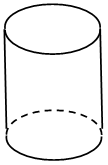
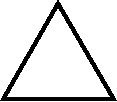
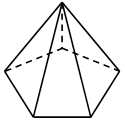
All objects are flat or voluminous.
What is the difference between flat figures and volumetric bodies? (Plane figures only have length and width, while solid bodies have length, height, and width.)
What is the structure of three-dimensional bodies? (Edges, faces, base, top).
- Who will show the listed parts of the volumetric bodies on the model?
- As a fixation, we execute second task(by options):
Option 1- Shade the front and top edges of the cube.
Option 2- Draw the missing ribs.
Option 3- Count the number of vertices in a pentagonal prism.
- Now let's play. Let's figure out who is “friends” with whom (an orange with a ball, a carrot with a cone, a lemon with an oval, a box with a rectangle).
III. Opening a new one.
1. Bodies of revolution and polyhedra.
- Volumetric bodies are also divided into two groups: bodies of revolution and polyhedrons.
Why do you think bodies of revolution? (A cylinder can be viewed as a solid obtained by rotating a rectangle around its side as an axis. A cone can be viewed as a solid obtained by rotating a right-angled triangle around its side as an axis.)
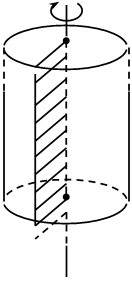
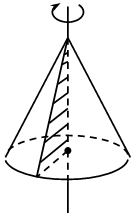
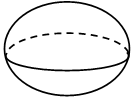
Take a look at the layout.
How to characterize polyhedra? (Polyhedron - geometric body, bounded on all sides by edges. The sides of the faces are called the edges of the polyhedron, and the ends of the edges are called the vertices of the polyhedron.)
How to depict volumetric figures?
Volumetric figures are depicted using chiaroscuro, otherwise it is impossible to show that they "rise" above the sheet of paper. And with the help of the dotted line, an invisible outline is drawn. Let's try to show the volume of bodies of revolution and polyhedrons using chiaroscuro. Third task:
Option 1 - a cone;
Option 2 - a pyramid;
Option 3 - cylinder. ( Analysis of works.)
2. The concept of "sweep".
- For the next challenge, assign each definition to a graphic.
Triangle, square, cube, pyramid, prism.

What difficulties have you encountered?
What is called a sweep of a volumetric body?
Why do you think it is called that? Try to formulate a definition.
- Unfolding in geometry- a set of geometric shapes, for which it is indicated how they should be connected to each other along the sides and vertices in order to obtain a given volumetric body.
In technology, sweep is called a flat workpiece or a drawing of a flat workpiece, from which the volumetric shape of a part or structure is obtained by bending.
So, we got acquainted with one more characteristic spatial figure- its scan. Consider the unfolding of some volumetric bodies.
What flat figures do they consist of (Cube, cylinder).
What do you need to know and be able to do to build a flat pattern of a geometric figure? Know:
what flat figures the body consists of (and how to build them);
how to connect these flat geometric shapes to each other.
Why do we need sweeps of geometric shapes? (For making models of polyhedrons. For example, boxes, packaging).
IV ... Physical education. ( Performed under the song "Point, point, comma ...")
Dot, dot, comma.
Draw with your hands in the air while squatting.
A funny face came out.
With your hands, grab the earlobes, show a face with turns of the body.
Handles, legs, cucumber
Show arms, legs, draw an oval with your hands in the air.
It turned out to be a little man.
Hands on the belt, turns the torso to the left, to the right.
What will these dots see
Simulate eyelid blinking with your hands.
What will these pens build
Hands in front of you, rotate with your hands.
How far will these legs take him?
March in place.
How will he live in the world?
Raise and lower your shoulders.
We are not responsible for this,
We drew it
That's all
Shrug your hands.
V. Practical work.
One of the important spatial geometric shapes is the cube.
Which flat figure is a face of a cube? (Square)
How many faces does a cube have? (6)
And now we will make a surprise box with you. To do this, on a piece of paper, draw along four identical squares with a side and two on the sides. As shown in the figure "Cube Unfold". Do not forget to make flaps around the edges of the squares with which you will glue the cube. Draw tightly along the fold lines with a clerical knife, but look carefully so as not to cut through. This way you can bend the cube more neatly. Bend the fold lines to form a cube? Now all that remains is to glue. Apply glue to the valves one by one, and glue them in order. Inside the box, you can fix the surprises you prepared earlier.
Vi. Exhibition and analysis of works.
Vii. Lesson summary. Reflection.
What characteristic of the spatial figure did you meet today?
What do you need to know and be able to do to build a flat pattern of a geometric figure?
Why do we need sweeps of geometric shapes?
VIII ... Homework. G. p. 70-71 (draw a scan of the cube, cut and glue the cube model, find the area of the entire surface of the cube and draw the same cube at a scale of 1: 1)
For those who have encountered these amazing models (I just want to say - creatures)
the world has split in two. One contains twisted strips of paper, messengers of fabulous measurements,
and in the remainder - unsightly, colorless vegetation.
E. Sklyarevsky
The purpose of the lesson: create conditions under which students "discover" the way to obtain a volumetric figure.
As a result, every student knows:
- What is called a sweep of a geometric body;
- How to build a flat pattern of a simple geometric body (there are several ways for some figures);
- What is the development of a geometric body for?
Each student is able to:
- To make a sweep of the simplest geometric body;
- Using this scan, recognize the geometric body for which it is drawn;
- Solve tasks for the development of spatial imagination.
Equipment:
- On the tables, each group has sets of models of stereometric bodies and flat figures;
- Sheets of paper (colored) for modeling sweeps;
- Handout sheets with cube sweeps;
- Handout sheets with Figure 9;
- Encyclopedias;
- Scissors, rulers, pencils.
Throughout the lesson, students work with information and research cards ( Annex 1). For clarity of perception, a presentation is used ( Appendix 2).
Course of the lesson
Stage 1
Guys, look at the pictures. What do you see on them? What unites them?
Picture 1
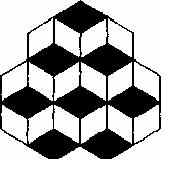
Figure 2

Figure 3
Discussion of drawings. The guys express their assumptions and try to argue for them.
Count how many cubes are shown in Figure 2?
The first drawing was created by E. Boring and called it "Lady and Old Woman". In the second picture, there may be 6 or 7 cubes (when viewed from above or below). The third picture seems to be a cube, but at the same time it is not a cube. Such assignments are considered ambiguous.
Stage 2
In our classes, we got acquainted with various geometric shapes. Let's remember with which ones.
Triangle, square, circle, rectangle, cube, cylinder, cone, pyramid, prism, ball, etc.
What unites them all?
Silence. Perplexity.
All these figures are "rigid" geometric figures, i.e. they cannot be changed without breaking. Only quite recently did the American geometer Connelly manage to construct a "cunning" polyhedron, which does not possess this property, but can change its shape so that each of its facets remains unchanged. This is a very complex polyhedron. The drawing gives some idea of it:
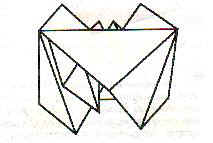
Figure 4
There is an interesting geometric toy that consists of triangles and changes, turning inside out. This is a FLEXAGON toy (from english word flex - "fold, bend". In other words, a flexagon is a flexible polygon. It has an amazing ability to suddenly change its shape and color. This is the polygon.
The teacher shows the flexagon.
This is also an ambiguous geometric figure. To figure out how this happens, you need to make this toy. But how???
Let's try to do this at the end of our lesson.
Stage 3
You have sets of geometric shapes on your tables. Try to divide them into groups so that in each group the objects are united according to some common feature. How did you divide them?
Flat and spatial (volumetric). The sign is the form.
Ok, now try for each of the figures of the 2nd group to find some figures from the 1st group so that they have something in common. Discuss all the options in the group and state your suggestions.
Discussion in pairs. Listening to students' answers.
- Cylinder - rectangle and two circles;
- Cone - circular sector and circle;
- Pyramid - square and 4 triangles;
- Prism, etc.
Explain your reasoning.
Each group explains their choice using one of the three-dimensional figures as an example.
Guys, the group of flat figures that you selected form a UNIFORM for this spatial figure.
Why do you think it is called that? Try to formulate a definition. Discuss all the options in the group. Write your definition on your card.
Listening to students' answers.
Find the definition of unfolding a geometric figure in the encyclopedias and dictionaries that you brought. Read and compare with your definition. Complete your definition. Read it.
Group work. One of the groups works with an electronic dictionary.
Listening to students' answers.
Stage 4
So, we got acquainted with one more characteristic of the spatial figure - its development. How do you find the unfolding of a geometric body? How to portray?
Try to depict the unfolding of the figure given to you. Discuss different ways images in the group.
- Group 1 - triangular pyramid
- 2 group - parallelepiped
- Group 3 - 4-sided pyramid
- 4 group - triangular prism
Use the models on your tables.
The groups represent different sweeps. Demonstration on a magnetic board.
What do you need to know and be able to do to build a flat pattern of a geometric figure?
You need to know what flat figures (polygons) the body consists of (and how to build them);
Know how to connect these flat geometric shapes to each other to get a sweep of the surface of a geometric body.
Stage 5
One of the important spatial geometric shapes is the cube. What are the faces of a cube?
Equal squares
Try to depict a flat pattern of a cube. Try to think of several ways. Discuss your options with the group.
Group work. Demonstration on a magnetic board.
Okay, from the shapes shown in this figure, select those that are unfolded cube, and transfer them to the map. Explain why you chose them.

Figure 5
Work in pairs.
Cut out these shapes and try to fold them into a cube.
Individual work with one of the models.
And now on the resulting sweeps, arrange the letters B, C, H, denoting the side, top and bottom faces of the cube. Distribute the drilldowns among the team members.
On the visible edges the cube contains the numbers 1, 2, 3. And on the sweeps - two of the named numbers or one. Arrange the numbers 1, 2, 3, 4, 5 and 6 on the unfolded cube so that the sum of the numbers on the opposite sides is 7.
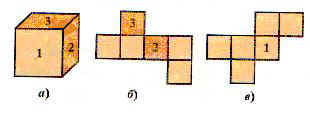
Figure 6
Frontal work with the class.
6 stage
Why do we need sweeps of geometric shapes?
For the manufacture of polyhedron models.
There is another way of making models of polyhedrons, in which they are woven from several strips of paper. See how this is done in the instruction sheet and simulate a cube.
Work in pairs.
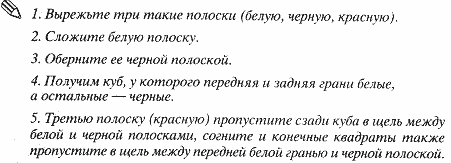
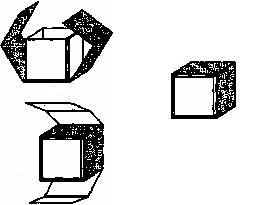
Figure 7
7 stage
Now look at the figures and tell me whether the flat geometric shapes depicted on them are unfolded surfaces of some geometric bodies. If so, which ones. If not, then what needs to be fixed.
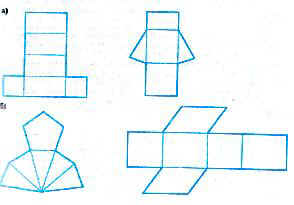
Figure 8
Work in pairs.
Name and depict a figure in your cards, a sweep of which can be made from the "pieces" shown in the figure
Group work. Each group works with one of the drawings. If difficult, students can cut out "pieces".
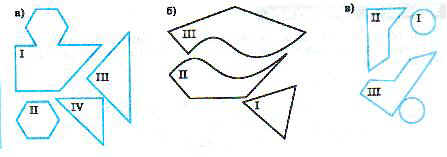
Figure 9
8 stage
Now let's go back to the beginning of our lesson. Do you remember what it was about?
What do you need to do to build a geometric shape? So how do you make a flexagon?
You need to draw a scan of it.
Stage 9. Reflection.
Do we all know about geometric shapes now? What do we know?
How do you know how much water will fit into a particular body, how much paint is required to paint the surface of the body? The task of building a flat pattern is just one of the tasks of geometry. But to deal with it, you need to talk about a lot more: not only to get acquainted with new geometric objects, but also to study the relationship between them.
Now try to answer the following questions
Individual work.
Today in the lesson I:
- Had seen
- Heard
- Felt
- Understood
- Learned
- I discovered that
Reading out answers at will.
Homework: try to display what you know about geometric shapes in the form of a diagram, drawing, story, crossword puzzle.
Make a flexagon.
Integrated lesson
using an interactive whiteboard
in mathematics and fine arts in grade 3
"Geometric figures. Unfold the cube. "
Prepared and conducted:
primary school teacher
E.O. Piletskaya,
art teacher
I. V. Guryanova
MOU SOSH № 29 "Harmony"
The date of the:
05/12/11
Pyatigorsk, 2011
Topic: "Geometric shapes. Cube development"
Goals:
- generalize ideas about flat geometric shapes and volumetric geometric bodies;
- create conditions under which students "discover" the way to obtain a volumetric figure.
Tasks:
- to consolidate knowledge on the classification of flat figures and volumetric bodies, their fundamental differences; to acquaint with the concepts of "bodies of revolution" and "polyhedra";
- create conditions for creative search in finding a correspondence between the spatial view of the cube and its flat image (scan);
- develop logical and spatial thinking, attention, memory, imagination, creativity;
- educate accuracy, compliance with safety rules when working with tools.
Equipment: interactive whiteboard, presentation, models of three-dimensional geometric shapes, handouts (individual cards).
During the classes.
I. Organizational moment.
II. Updating basic knowledge.
Primary school teacher: - Guys, today our lesson is about geometry.
Let's remember what geometry is? (Translated from Greek, the word "geometry" means "surveying." In mathematics, "geometry" is the science that studies geometric shapes and their properties)
Primary school teacher: - What geometric shapes do you know? (Square, rectangle, cube, ball, etc.)
Primary school teacher: - What types can these geometric shapes be divided into? (Volumetric geometric bodies, flat geometric shapes, basic geometric concepts)
Primary school teacher: - The topic of our lesson is "Plane Shapes and Volumetric Bodies".
Fine art teacher: - Here's your first task. It is necessary to paint flat figures with warm colors, and volumetric bodies with cold ones. Let's remember which colors are called warm and which are cold?
Primary school teacher: - All objects are flat or voluminous.
What is the difference between flat figures and volumetric bodies? (Plane figures only have length and width, while solid bodies have length, height, and width.)
Primary school teacher: - What is the structure of three-dimensional bodies? (Edges, faces, base, top).
- Who will show the listed parts of the volumetric bodies on the model?
Primary teacher: -As a fixation, we execute second task (by options):
Option 1 - Shade the front and top edges of the cube.
Option 2 - Draw the missing ribs.
Option 3 - Count the number of vertices in a pentagonal prism.
Primary teacher: -Now let's play. Let's figure out who is “friends” with whom (an orange with a ball, a carrot with a cone, a lemon with an oval, a box with a rectangle).
III. Opening a new one.
1. Bodies of revolution and polyhedra.
Primary teacher: -Volumetric bodies are also divided into two groups: bodies of revolution and polyhedrons.
Why do you think bodies of revolution ? (A cylinder can be viewed as a solid obtained by rotating a rectangle around its side as an axis. A cone can be viewed as a solid obtained by rotating a right-angled triangle around its side as an axis.)
Fine art teacher: - Look at the layout.
Primary school teacher: - How to characterize polyhedra? (A polyhedron is a geometric body bounded on all sides by faces. The sides of the faces are called the edges of the polyhedron, and the ends of the edges are called the vertices of the polyhedron.)
Fine art teacher: - How to depict volumetric figures?
Volumetric figures are depicted using chiaroscuro, otherwise it is impossible to show that they "rise" above the sheet of paper. And with the help of the dotted line, an invisible outline is drawn. Let's try to show the volume of bodies of revolution and polyhedrons using chiaroscuro. Third task:
Option 1 - a cone;
Option 2 - a pyramid;
Option 3 - cylinder.(Analysis of works.)
2. The concept of "sweep".
Primary teacher: -Let's proceed to the next task.Match each definition with a graphic.
Triangle, square, cube, pyramid, prism.
What difficulties have you encountered?
What is called a sweep of a volumetric body?
Why do you think it is called that? Try to formulate a definition.
Primary teacher: -Unfolding in geometry- a set of geometric shapes, for which it is indicated how they should be connected to each other along the sides and vertices in order to obtain a given volumetric body.
In technology, sweepis called a flat workpiece or a drawing of a flat workpiece, from which the volumetric shape of a part or structure is obtained by bending.
So, we got acquainted with one more characteristic of the spatial figure - its development. Consider the sweep of some solid bodies.
What flat figures do they consist of (Cube, cylinder).
Fine art teacher: - What do you need to know and be able to do to build a sweep of a geometric figure? Know:
- what flat figures the body consists of (and how to build them);
- how to connect these flat geometric shapes to each other.
Why do we need sweeps of geometric shapes? (For making models of polyhedrons. For example, boxes, packaging).
IV. Physical education. (Performed under the song "Point, point, comma ...")
Dot, dot, comma. | Draw with your hands in the air while squatting. |
A funny face came out. | With your hands, grab the earlobes, show a face with turns of the body. |
Handles, legs, cucumber | Show arms, legs, draw an oval with your hands in the air. |
It turned out to be a little man. | Hands on the belt, turns the torso to the left, to the right. |
What will these dots see | Simulate eyelid blinking with your hands. |
What will these pens build | Hands in front of you, rotate with your hands. |
How far will these legs take him? | March in place. |
How will he live in the world? | Raise and lower your shoulders. |
We are not responsible for this, | |
We drew it | |
That's all | Shrug your hands. |
V. Practical work.
Fine art teacher: - One of the important spatial geometric shapes is the cube.
Which flat figure is the face of a cube? (Square)
How many faces does a cube have? (6)
And now we will make a surprise box with you. To do this, on a piece of paper, draw along four identical squares with a side and two on the sides. As shown in the figure "Cube Unfold". Do not forget to make flaps around the edges of the squares with which you will glue the cube. Draw tightly along the fold lines with a clerical knife, but look carefully so as not to cut through. This way you can bend the cube more neatly. Bend the fold lines to form a cube? Now all that remains is to glue. Apply glue to the valves one by one, and glue them in order. Inside the box, you can fix the surprises you prepared earlier.Vi. Exhibition and analysis of works.